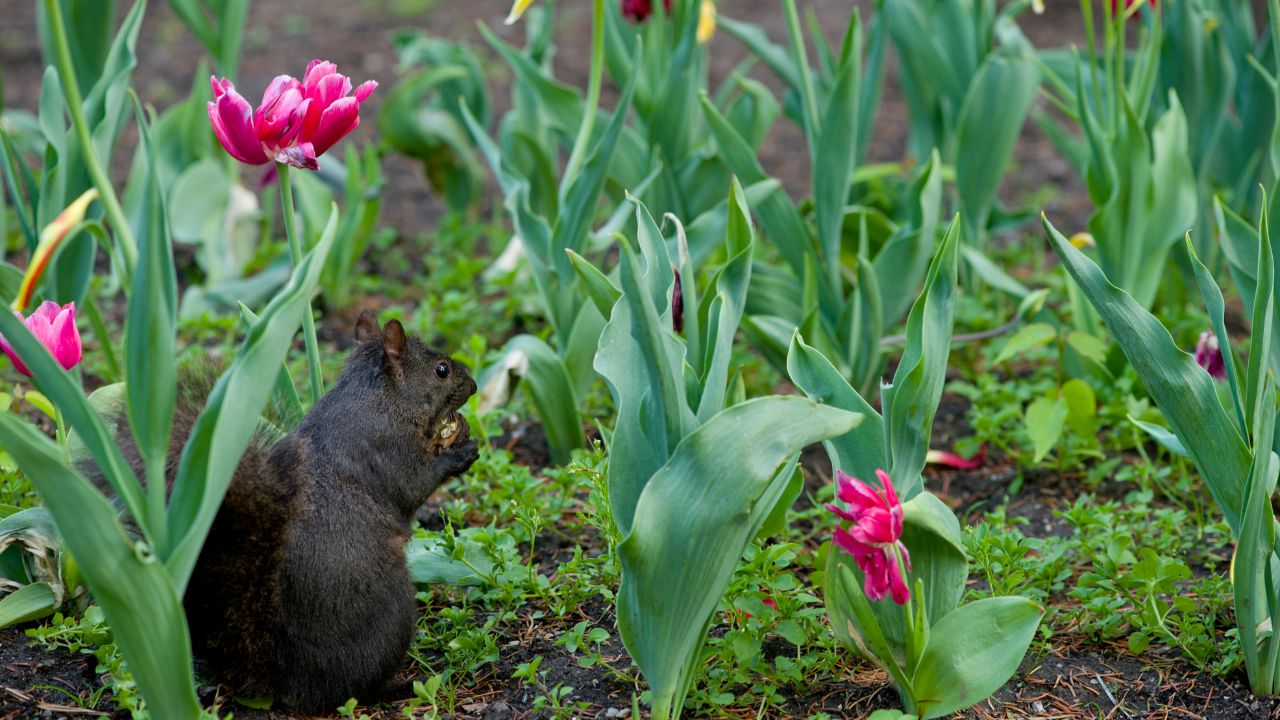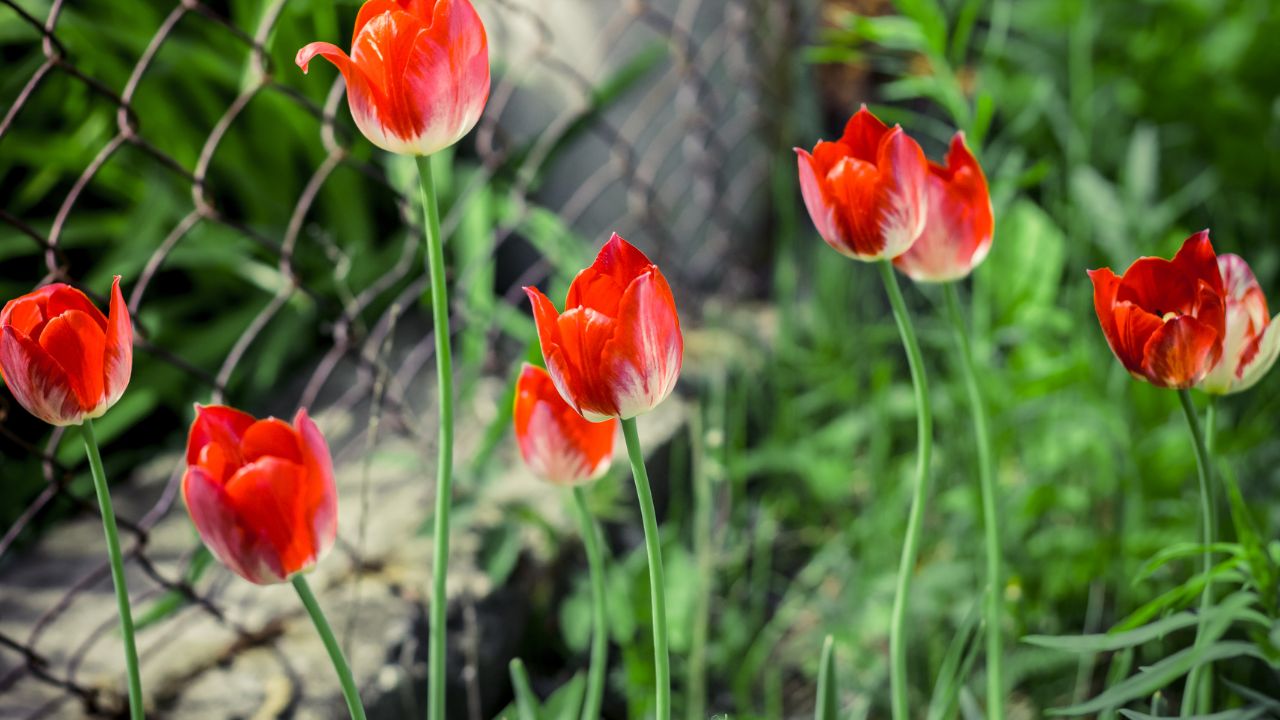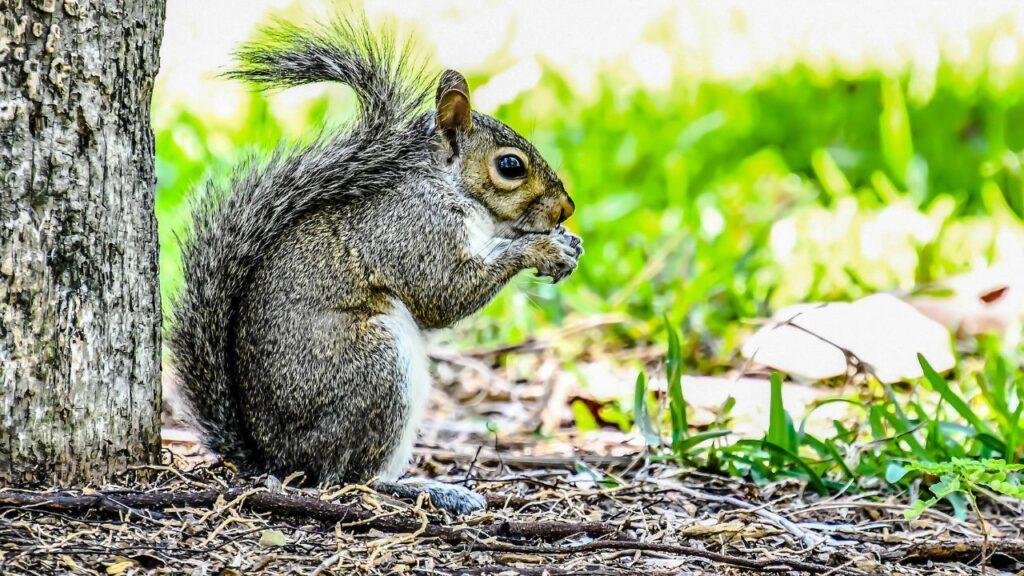Gardeners, be vigilant! A notorious gang of furry bandits lurks among the flower beds, waiting to snatch away prized possessions: tulip bulbs. These cunning creatures, known as squirrels, have developed a taste for the bulbs and will stop at nothing to feast on their nutritious goodness.
In case you’re wondering, yes, squirrels do eat tulip bulbs. With a penchant for the scrumptious underground corms and delicate flowers, they dig up tulip bulbs meticulously and munch on them right away or store them as reserves for later snacking sessions. Thus, tulip enthusiasts must arm themselves with knowledge and implement strategies to defend their blooms from these mischievous bulb burglars.
Squirrel Dining Habits
Gourmet or Go-Getter?
Squirrels would probably win the animal kingdom’s version of a buffet race. They’re agile, quick, and have a knack for finding food in the strangest places. One of their favorite treats, though, comes in the form of tulip bulbs.
These little critters love to dig up, store, and munch on those nutritious underground corms. They might not have the sophisticated palate of a French chef, but squirrels aren’t picky; they’re go-getters when it comes to food.
When it comes to tulip bulbs, squirrels seem to treat them like a bag of chips – they just can’t resist the temptation (crunch). Now, let’s take a closer look at their snacking habits:
- Tulip Digging: You’ll likely spot a few furry friends burying their heads in your flower beds. What are they after? Those succulent, tasty tulip bulbs that many gardeners pride themselves on growing.
- Tasty Tulips: Who knew that squirrels and humans shared a mutual appreciation for flowers? Their allure doesn’t stop at admiring the vibrant colors; squirrels are quite fond of devouring their bulb-y goodness.
- Storing Tulip Bulbs: Winter is coming, and squirrels love to stock up on tulip bulbs like they’re preparing for a cold-weather hibernation binge. The next time your tulips disappear, blame the adorable yet mischievous squirrel hoarding them for later consumption.
- Nom-Nom-Nibbling: Have you ever witnessed a squirrel ravenously devouring a tulip bulb? It’s as if they know their indulgence anguishes gardeners everywhere, but they can’t resist the satisfaction of devouring (italic)tasty, nutritious tulip bulbs(italic).
In short, squirrels are both gourmets and go-getters when it comes to their eating habits. It’s a love-and-hate relationship between these furry creatures and the gardeners trying to protect their precious tulips. The words “stop and smell the roses” don’t really apply to squirrels; they would much rather eat the tulip bulbs instead.

Tulip Bulb Buffet: Squirrels’ Delight?
Ah, tulips. These beautiful flowers grace our gardens with their vibrant colors each spring. But have you ever planted tulips only to watch in horror as squirrels feast on their bulbs? Well, fear not. We’ve done some digging (pun intended) to find out more about squirrels and their appetite for tulip bulbs.
For starters, let’s confirm our suspicions. Yes, squirrels do eat tulip bulbs. These mischievous rodents are particularly fond of nutritious underground corms and tasty flowers. Who can blame them? Tulip bulbs are like tasty treats from the earth, and squirrels are well-equipped to dig them up and enjoy a meal or store them for later consumption.
Now that we’ve established squirrels as tulip-lovers, here are three quick facts about their dining habits:
- Digging: Squirrels have a knack for uncovering the juiciest tulip bulbs.
- Storing: After finding a bulb, they may save it for later consumption, possibly even hoarding a whole collection for themselves.
- Consuming: Tulip bulbs are a delicious snack for squirrels, either enjoyed immediately or stored away.
So how can you protect your precious tulips from these bulb-gobbling creatures? Well, there are several methods to keep those pesky squirrels away from your tulip bulbs. Here are three tips to get started:
- Cage It: Place a mesh cage over bulbs before adding soil while planting.
- Spray It: Apply a squirrel-repellent spray or natural deterrent like garlic to the bulbs.
- Disguise It: Plant daffodils, which are not attractive to squirrels, around your tulip bulbs as a form of camouflage.
While it may take some effort to protect your tulips, implementing these tips can lead to a garden full of blooming beauties untouched by the paws of those bulb-binging squirrels. Happy gardening!
Garden Defense 101: Protecting Your Petals
In the never-ending battle between gardeners and squirrels, one must be well-prepared to protect their precious tulip bulbs from these furry opponents. Here are some tactics to help you defend your garden and ensure that your tulips bloom to their full potential.

Fancy Fencing Tactics
One way to outsmart our bushy-tailed adversaries is to use fencing. This doesn’t mean you should start practicing your sword fighting skills—instead, consider surrounding your garden with physical barriers.
- Chicken wire or hardware cloth: Cover the planting area with chicken wire or hardware cloth, both of which have a small grid pattern that prevents squirrels from reaching your bulbs. You can lay the wire on top of the soil or create a cage-like enclosure around the bulbs.
- Garden netting: This lightweight and inexpensive option can be draped over your bulbs or plants to deter squirrels from munching on your blooms.
Remember, squirrels can be crafty, so it’s crucial to ensure your fence is sturdy and secure!
Odoriferous Obstacles
Squirrels may have an excellent sense of smell, but that doesn’t mean they’re fans of every aroma. Here are a few odor-based approaches to make your tulips less appetizing to the enemy:
- Natural repellents: Certain plants can act as squirrel repellents, like garlic or onions. Plant these pungent plants near your tulips to create an olfactory barrier.
- Pre-treat your bulbs: Before placing your tulip bulbs in the ground, coat them with squirrel repellents such as hot pepper wax or taste deterrents. This will give them unanticipated spicy mouthfuls and deter them from coming back for seconds.
- Commercial repellents: You can also purchase commercial squirrel repellents for your garden, such as granules or sprays. These products usually contain strong-smelling substances that squirrels find unappealing.
With determination, wit, and these garden defense strategies, you can outmaneuver squirrels and keep your petals protected. Stay vigilant, and may your tulips thrive!
Botanical Bites: What Else Is on the Menu?
Squirrels are undoubtedly the furry rascals of our gardens. With their cute faces and bushy tails, they reign supreme on garden heists while feasting on virtually anything they come across. Though they especially enjoy tasting tulip bulbs, their palates are far from limited. So, what other garden delights are squirrels tempted by? Well, let’s dive into their scrumptious botanical menu.
Appetizers:
- Flower petals, a la carte, for a vibrant start
- Fresh strawberries, served with a dash of garden dirt
- Sunflower seeds, because everyone needs protein
Squirrels commence their dining experience with a colorful array of flower petals. For a delightful change of pace, they might snatch a few strawberries straight off the plant. And, as every gourmet critter knows, a sprinkle of sunflower seeds adds the perfect punch of protein to these appetizing bites.
Main Courses:
- Crunchy tree bark, served with a side of nuts
- Delectable garden vegetables, tossed in mischief
- Tender plant cuttings, for the connoisseur
When it’s time for the entrée, squirrels raise the bar even higher. Who can resist the alluring crunch of tree bark, especially when paired with a delightful selection of nuts? A medley of garden vegetables, freshly ransacked, never disappoints. And for those seeking a more refined experience, plant cuttings provide outstanding flavors with a delicate touch.
The Finishing Touch:
- Aromatic bulbs, because they can’t resist their epic flavor
Don’t think our furry friends will leave without indulging in tulip bulbs, the epitome of fine squirrel dining. This bulb offers an explosive taste that no self-respecting squirrel can pass up. It’s the pièce de résistance to this eclectic botanical banquet.
And there you have it! This meticulously crafted menu gives you a taste (excuse the pun) of a squirrel’s delightful garden dining experience. Next time you notice a squirrel hopping around your garden, try to envision them somersaulting into a lavish botanical feast.
Frequently Asked Questions
What gourmet delights do squirrels find in my garden’s tulip buffet?
Squirrels are quite the connoisseurs when it comes to tulip bulbs. These furry little critters consider your tulip bulbs a protein-rich delicacy, making your garden a perfect dining spot. So, don’t be too surprised when you find them nibbling on your tulip bulbs with a cheeky grin.
Do those furry rascals have a taste for bulbous crocus delicacies too?
Unfortunately, tulips aren’t the only bulbous delights on the squirrel menu. They’re also quite fond of other bulbs, such as crocuses and grape hyacinths. Your garden is like a fancy restaurant offering a diverse menu for those pesky squirrels.
Is it all-you-can-eat season for squirrels with my allium bulbs as the main dish?
Well, here’s some good news – squirrels aren’t as interested in allium bulbs as they are in tulips, crocuses, and hyacinths. Alliums tend to have a pungent aroma that squirrels find less appealing, making it less likely for them to munch on these bulbs.
Got any clever tricks to squirrel-proof my precious bulbs?
Certainly! One effective way to protect your tulips from squirrels is to plant them at the proper depth – about 6 to 8 inches deep for tulips, daffodils, and hyacinths, and 3 to 4 inches deep for smaller bulbs like grape hyacinths and crocuses.
What’s the secret spice to keep those dig-happy squirrels at bay?
One successful strategy for deterring squirrels is to sprinkle a generous amount of crushed red pepper flakes or other spicy repellant around your bulbs, as squirrels generally don’t like spicy flavors. However, you might need to reapply the spice after heavy rain or watering.
What’s the underground scoop on how deep squirrels will tunnel for a bulbous snack?
Squirrels are experts in digging for their favorite treats, but when it comes to tulip bulbs, planting them at the recommended 6 to 8 inches deep should help to deter most squirrels. Their digging prowess usually focuses on shallower depths, making it less likely for them to get through the deeper bulbs – thereby saving your precious tulips from a furry fate.
Becky is a fervent wildlife enthusiast and pet care expert with a diploma in canine nutrition. Her love for animals stretches beyond the domestic, embracing the wild tapestry of global fauna. With over a decade of experience in animal welfare, Becky lends her expertise to OutlandishOwl through insightful articles, captivating wildlife information, and invaluable guidance on pet nutrition. Her work embodies a deep commitment to understanding the intricate lives of animals and a passion for educating others on sustaining natural habitats. Becky's hands-on conservation efforts and her knack for translating complex dietary science into practical pet feeding tips make her an indispensable voice for creatures great and small.




